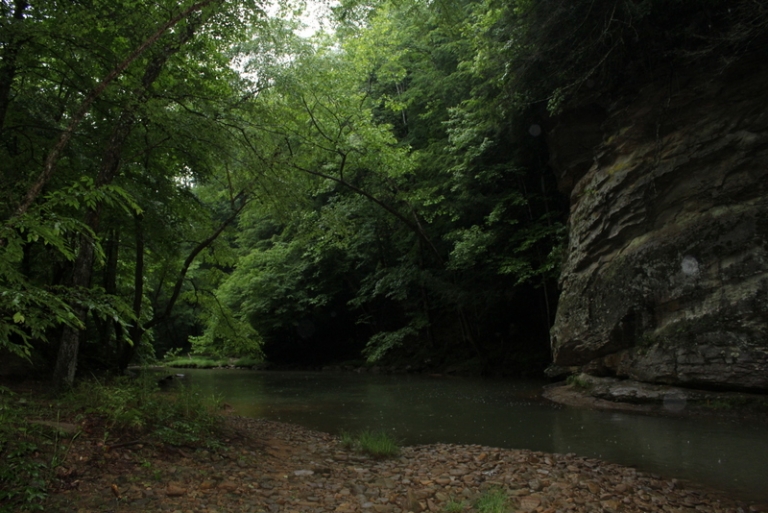STRANGE CREEK, W.Va. — Too much time may have passed to confirm anything of the indomitable legend of Strange Creek, long among the most haunting tales in West Virginia history. Few travelers now pass through the old town by that name or ascend the stream that follows a winding course from the Elk River into the forests of central West Virginia.
Might the bones of William Strange, for whom Strange Creek is named, ever be found? The late historian Charles Carpenter, of Grafton, West Virginia, spent years considering the tale and surveying the stream and the surrounding countryside and never found anything to confirm the legend.
Yet, as he points out, the tale of Strange is based in fact, and the events speak to an important time in West Virginia history when the Shawnee of Ohio presented a threat to settlers and surveyors. Fifty years after Carpenter penned the following, it may be that nothing is left to confirm the following tale.
The Legend of Strange Creek
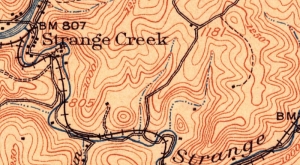
Perhaps most native of all our legends is the Strange Creek legend, often heard and widely known in the central counties of West Virginia. This story possesses the charm and fascination characteristic of all folklore, and being, as it is, "a tale that holdeth children from play and old men from the chimney-corner," it has become widely disseminated.
The Strange Creek legend is based, as most legends are, on an actual historical occurrence. But having its inception in, and its foundation on, an actual event is all one can say as to its authenticity. The story must have been gradually elaborated into its present general outlines around hearth fires, wherein days past many tales were told to beguile the long and lonesome evenings and nights, an art that is almost lost today.
This local legend is used on the traditional accounts told of William Strange, a pioneer settler who lost his way in the wilderness of the Elk River valley near the close of the 18th century and perished at some unknown spot in the forest land of that section.
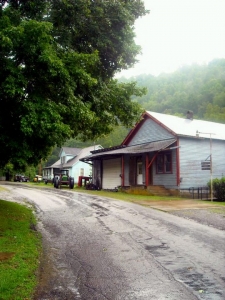
At more than one place in the mountains, bones have been discovered that were thought to be those of Strange. Likewise, two or three old rusty guns have been found that were supposed to be the one in his possession when he was lost.
The story, as it has been handed down, says that William Strange came into the Elk Valley with a party to make a survey of some lands in the region. The surveying party was alleged to have been made up of Henry Jackson, who was a surveyor, one Hall, one Reger, and William Strange. They came from what is now Upshur County to the Elk near the confluence of the Holly River. Here they employed Jeremiah Carpenter, who lived on the Elk near the mouth of the Holly, to guide them.
At the time, there were no settlements in this section other than the home of Carpenter. Except what little space Jeremiah and a brother, who had been killed by Indians, had cleared along the Elk, the whole country was a vast thickly wooded expanse.
While making the survey, William Strange was to do the cooking and have charge of the food and utensils. These necessities were carried on a horse.
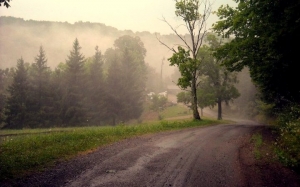
The first day in the forest, while trying to follow a direction to a certain point that the guide had set as a meeting point in the evening, Strange lost his way. The other members of the surveying party stayed at the home of Carpenter that night and the next day went in search of the lost Strange. They found that after Strange had wandered with his packhorse back and forth over some miles, he had tied the horse to a bush and proceeded unhampered by the animal.
After finding the horse, the searching party continued several miles to a spot where Strange had evidently slept. Near this place, one of the party fired his gun, thinking that Strange might hear it and come to them. It had been only about two years since Carpenter's brother was killed by the Indians, and, fearing that some roaming savages might be in hearing and ambush them, Carpenter remonstrated with the man for firing his gun. For this reason, no more shots were fired.
The trail of Strange was followed a few miles farther into the mountains and then the track was lost. He was never heard of afterward. Years later—no one seems to have an idea of the number—it was said that some hunters found the bones of Strange at the foot of a large beech tree upon which his name had been cut with the following couplet:
"Strange is my name, and I'm on strange ground,
And strange it is that I can't be found."
This beech tree is said to have stood on what was called Turkey Creek. The appellation was at the time changed to Strange Creek, which name the stream still bears.
The first printed record of this unusual story, so far as I know, is the account of it in George Atkinson's History of Kanawha County, printed in 1876. As the incident occurred in what was at the time a part of Kanawha County, the author, who was later to become governor of West Virginia, saw fit to cover the legend at some length in his history of the county.
John P. Hale's Trans-Allegheny Pioneers, which was published some years after Atkinson's history, touches upon the legend. Atkinson's account has been reprinted in full in Lucullus V. McWhorter's Border Settlers of North-Western Virginia and with it appears further information pertaining to the story from various sources. The author of Border Settlers quotes a version of the legend given him 20 years or more before by a resident of Buckhannon, West Virginia, in which the couplet on the tree is said to have been:
"William Strange is my name,
And in these strange woods, I must remain."
This version states that the bones of the lost man were said to have been found on Sugar Creek in Braxton County. Having an interest in native lore, legends, and local history, I have taken some trouble to look into the Strange Creek story at different times, as the opportunity presented.
I have made some attempt to locate the spot where stood the tree upon which the lost William Strange is said to have cut his name and the couplet. It has proven something very elusive, indeed. I have heard that it was at the mouth of Strange Creek, but old men and women in that neighborhood, so far as I have been able to learn, have never come into contact with anyone who has seen the tree.
Some reports have put it near Dille post office, which is on a branch of Strange Creek in the edge of Clay County just across the Nicholas County line. In this section one also seeks in vain for definite information as to where the tree was located. All I ran into in this particular region was a version of the story in which this variation of the verse occurs:
"My name is Strange, and I'm on strange ground,
I'm lost in the woods, and I know I'll not be found."
As there is no Sugar Creek in Braxton County, Sugar Camp Run, which flows into the Elk on the north side a few miles above Strange Creek, was tried. This creek is on the wrong side of the Elk for the story, but it is the only creek in Braxton County with a name similar to Sugar Creek, and it is often called by that name locally.
No success, however, meets the investigator in this immediate section. Here one cannot even find existent the tradition that the bones of Strange were found on the waters of Sugar Camp Run.
Although beyond doubt, the interesting legend, as has been said, is founded on an incident that actually occurred, the embellished story itself is a folk tale, pure and simple —as much one as are the Marchen that fill the pages of the volumes of the Brothers Grimm. But it is a fine folk tale. Where can we find a native one that is better?
It is worthy of mention that although there are no Stranges in the two or three middle counties of West Virginia today, a William Strange enlisted in Company I of the 17th Virginia Regiment of the Confederate Army, which was mustered into service October 2, 1862, at Birch River Post Office in Nicholas County. This place is only a few miles from the headwaters of Strange Creek.
Winter chill recalls legend of Braxton County bear hunter
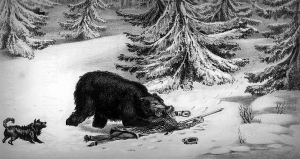
The mountains that tower above the Birch River weather the brunt of winter storms that sweep across central West Virginia, and among them on a snowy night, an epic battle between man and nature was fought. Though his legend has grown obscure, Bill Barnett was a hero in the hills where Braxton and Nicholas counties join—known far and wide as the greatest of the bear hunters. Read the full story here.
Sign up to receive a FREE copy of West Virginia Explorer Magazine in your email weekly. Sign me up!

























